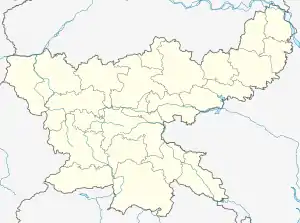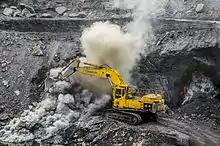Jharia coalfield
Jharia coalfield is a large coal field located in the east of India in Jharia, Jharkhand. Jharia represents the largest coal reserves in India having estimated reserves of 19.4 billion tonnes of coking coal.[1] The coalfield is an important contributor to the local economy, employing much of the local population either directly or indirectly.[2]
| Location | |
|---|---|
 Jharia coalfield | |
| Jharkhand | |
| Country | India |
| Coordinates | 23°45′5.6″N 86°25′13.2″E |
| Production | |
| Products | Coking coal |
The fields have suffered a coal bed fire since at least 1916, resulting in 37 millions tons of coal consumed by the fire, and significant ground subsidence and water and air pollution in local communities including the city of Jharia. The resulting pollution has led to a government agency designated for moving local populations, however, little progress has been made in the relocation.
Coal field

The coal field lies in the Damodar River Valley, and covers about 110 square miles (280 square km), and produces bituminous coal suitable for coke. Most of India's coal comes from Jharia. Jharia coal mines are India's most important storehouse[3] of prime coke coal used in blast furnaces, it consists of 23 large underground and nine large open cast mines.[4]
History
The mining activities in these coalfields started in 1894 and had really intensified in 1925. The first Indians to arrive and break monopoly of British in Coal mining were Gujarati railway contractors from Kutch[5] some of whom decided to plunge into the coal mining business and were thus the pioneers in starting coal mining in Jharia coalfields belt around 1890–95.[6] In Jharia-Dhanbad belt Seth Khora Ramji Chawda was the first Indian to break monopoly of Europeans and founded Khas Jharia, Golden Jharia, Fatehpur, Balihari, Khas Jeenagora, East Bagatdih Collieries with their brothers Teja Ramji Chawda, Jetha Lira Jethwa, Akhoy Ramji Chawda, Pachan Ramji Chowra between 1894 and 1910. In Pure Jharia Colliery Khora Ramji and brothers were partners with Diwan Bahadur D.D. Thacker.[7] [8] [9] [10][11] The Encyclopaedia of Bengal, Bihar & Orissa (1920) by British Gazetteer mentions about Seth Khora Ramji as under :-
..at that time (in 1890s) the Jharia coal fields were being exploited by Europeans and Seth Khora Ramji was first Indian to seize the opportunity. He purchased two collieries to begin with. Gradually others from Kutch and Gujarat followed suit and now Jharia has been changed into a Gujarati settlement with about 50 Kutchi out of 92 Gujarati collieries proprietors with Seth Khora Ramji as head of them all. He is now sole proprietor of two collieries and a financing member of about eight collieries. Several district officials have remarked him as multi-millionaire, one of the first class parties in Jharia.
The life sketch of Govamal Jivan Chauhan is also another miner mentioned by the British in Gazetteer[12] who founded collieries at Teesra, Budroochuck and Pandeberra around 1908–10, Jagmal Raja Chauhan owned Rajapore colliery with Manji Jeram of Madhapar,[7] while Khimji Walji owned Tisra mines[7] The migrants took on lease the coal mining fields from Raja of Jharia at various locations to start collieries at Khas Jharia, Jamadoba, Balihari, Tisra, Katrasgarh, Kailudih, Kusunda, Govindpur, Sijua, Sijhua, Loyabad, Joyrampur, Bhaga, Matadih, Mohuda, Dhansar, Bhuli, Bermo, Mugma, Chasnala-Bokaro, Bugatdih, Putki, Pandibri, Rajapur, Jeenagora, Gareria, Chirkunda, Bhowrah, Sinidih, Kendwadih, Dumka, etc.[7][13] [14]
Coal field fire
Jharia is famous for a coal field fire that has burned underground for nearly a century. A 2007 estimate, described 37 million tons of coal consumed by the fires since their start.[15][16]
The first fire was detected in 1916.[4] According to records, it was the Khas Jharia mines of Seth Khora Ramji Chawda (1860–1923), who was a pioneer of Indian coalmines, whose mines were one of the firsts to collapse in underground fire in 1930. Two of his collieries, Khas Jharia and Golden Jharia, which worked on maximum 260-foot-deep shafts,[17] collapsed due to now infamous underground fires, in which their house and bungalow also collapsed on 8 November 1930, causing 18 feet subsidence and widespread destruction.[8][10][17][18][19][20] The fire never stopped despite sincere efforts by mines department and railway authorities and in 1933 flaming crevasses lead to exodus of many residents.[17] The 1934 Nepal–Bihar earthquake led to further spread of fire and by 1938 the authorities had declared that there is raging fire beneath the town with 42 collieries out of 133 on fire.[21]
In 1972, more than 70 mine fires were reported in this region. As of 2007, more than 400,000 people who live in Jharia are living on land in danger of subsidence due to the fires, and according to Satya Pratap Singh, "Jharia township is on the brink of an ecological and human disaster".[22] The government has been criticized for a perceived lackadaisical attitude[23] towards the safety of the people of Jharia.[24] Heavy fumes emitted by the fires[25] lead to severe health problems such as breathing disorders and skin diseases among the local population.[26]
References
- "Coal in India" (PDF). ibm.nic.in. 2012. Archived from the original (PDF) on 11 August 2013. Retrieved 23 July 2013.
- Pai, Sandeep; Carr-Wilson, Savannah (2018). Total Transition: The Human Side of the Renewable Energy Revolution. Rocky Mountain Books. ISBN 978-1-77160-248-8.
- "The Jharia coal field fire". Archived from the original on 13 July 2007. Retrieved 2 February 2016.
- Jharia to be shifted, The Times of India, 31 Aug 2006
- Town survey report: Bihar, Dhanbad by Rajendra Prasad Assistant Director of Census Operations, Bihar S. C. Saxena Deputy Director of Census Operations, Bihar. 1988 :pp 22: It was the existence of coal that first attracted the railway authority to extend the railways and with them came the Gujrati people as an expert railway contractor with an experience of railway construction work at Thana. They then met Raja of Jharia and purchased some having underneath wast [sic] wealth in shape of coal...
- Census of India, 1981: Bihar. Series 4. Controller of Publications – Bihar. 1981. p. 22.
It was the existence of coal that first attracted the railway authority to extend the railways and with them came the Gujrati people as an expert railway contractor with an experience of railway construction work at Thana. They then met Raja of Jharia and purchased some having underneath wast wealth in shape of coal
- Diary of Golden Days at Jharia – A Memoir & History of Gurjar Kashtriya Samaj of Kutch in Coalfields of Jharia – written by Natwarlal Devram Jethwa of Calcutta/Sinugra compiled by Raja Pawan Jethwa: 1998
- Gazetteers of Bengal, Assam, Bihar & Orissa 1917 Khora Ramji Colliries
- Ambalal Khora Ramji Legal 1
- Khora Ramji Mines capsized in 1938
- Encyclopedia of Bengal, Bihar & Orissa by British Authorities – 1920 : People from the region : Life sketch of Seth Khora Ramji Chawra noted in 1920
- The Encyclopaedia of Bengal, Bihar & Orissa (1925) by British Gazetteer
- Coking Coal Nationalisation Act of 1972 Archived 2012-03-13 at the Wayback Machine
- "Coal Mines Nationalization Act, 1973" (PDF). Archived from the original (PDF) on 16 July 2011. Retrieved 2 February 2016.
- "The Human Cost Of India's Push to Produce More Coal". Yale E360. Retrieved 2 August 2020.
- Stracher, Glenn B. (2007). "Coal fires burning around the world: Opportunity for innovative and interdisciplinary research" (PDF). GSA Today. 17 (11): 36. doi:10.1130/GSAT01711GW.1. ISSN 1052-5173.
- Amin, Samir; Amin, Shahid; Linden, Marcel van der (1997). Peripheral Labour: Studies in the History of Partial Proletarianization edited by Shahid Amin, Marcel van der Linden. p. 83. ISBN 9780521589000.
- Diary of Golden Days at Jharia – A Memoir & History of Gurjar Kashtriya Samaj of Kutch in Coalfields of Jharia – written by Natwarlal Devram Jethwa:1998 Page:12
- Nanji Bapa ni Nondh-pothi published in Gujarati in year 1999 from Vadodara. It is a diary of Railway Contracts done by KGK community noted by Nanji Govindji Tank of Jamshedpur, compiled by Dharsibhai Jethalal Tank, Tatanagar. (Aank Sidhhi awarded to book by Kutch Shakti at Mumbai in 2000): Life Sketch of Seth Khora Ramji Chawra Page :76
- The Jharia underground fire still raging first came to notice in November, 1930 with subsidance at Seth Khora Ramji's Khas Jharia Colliery(Page 159). He was told that Seth Khora Ramji, whose mines lay underneath Jharia, had chosen to live in his house, which also collapsed in subsidance(Page 160). "The politics of labour under late colonialism: workers, unions, and the state in Chota Nagpur, 1928–1939 by Dilip Simeon."
- Searchlight, 24 January 1936.
- Hindustan Times, 15 December 2007
- The Jharia mine fire control technical assistance project: an analysis, April 2004
- "Inside Coal Mine Fires", a documentary, 2005
- ESTIMATION OF GAS EMISSIONS FROM SHALLOW SUBSURFACE COAL FIRES IN JHARIA COALFIELD
- In the line of fire, indiatogether.org
Further reading
- Reinventing Jharia Coalfield. Edited by N.C. Saxena, Gurdeep Singh, K.N. Singh and B.N. Pan. Jodhpur, Scientific, 2005, vi, 246 p.. ISBN 81-7233-398-6.
- "Satellites track the fires raging beneath India". New Scientist (2560). 18 July 2006.
- Roychowdhury, Indronil (15 October 2006). "German major eyes Jharia coal fires". Kolkata Newsline. Retrieved 2 May 2009.
- Sethi, Aman (18 November – 1 December 2006). "Burning issue". Frontline. The Hindu. Retrieved 2 May 2009.
- "India: Children of the Inferno". Unreported World. Season 17. Episode 7. 24 April 2009.
- "Coal mine fires an election issue in Jharkhand". The Hindu. 12 April 2009. Archived from the original on 4 November 2012. Retrieved 2 May 2009.
- "Web documentary about the people who live in proximity to the underground coal fires". Bombay Flying Club - www.bombayfc.com. 6 May 2009. Retrieved 2 May 2009.
- eBook about the Jharia Coalfields, Zipfel, Isabell https://www.amazon.com/The-Jharia-Coalfields-ebook/dp/B0095I2AH4
- "Solar, Eclipsed: Coal? or the Sun? The Power Source India Chooses May Decide the Fate of the Entire Planet." By Charles C. Mann. Wired, November 2015. https://www.wired.com/2015/11/climate-change-in-india/
External links
- Official data on Jharia Block
- Official map of Dhanbad district
- JHARIA BURNING – Track the heat. Locate the people, the coal and the fire
- Pictures of the coal town of Jharia
